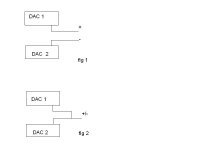Hi
In both cases the sound is worse, in comparison with sole DAC, because there are no two completely identical DACs, everyone always have some disorder of parameters (in a case with R-2R).
In both cases the sound is worse, in comparison with sole DAC, because there are no two completely identical DACs, everyone always have some disorder of parameters (in a case with R-2R).
Õàëÿâùèê said:Hi
In both cases the sound is worse, in comparison with sole DAC, because there are no two completely identical DACs, everyone always have some disorder of parameters (in a case with R-2R).
I would have said the opposite.
You're right on the fact that the DACs aren't 100% identical. But since theyr "drift", "distortion" or whatever you call it, is a kind of random error, placing multiple dacs will tend to cancel this, and will give you an output that is the mean value of all the dac's output. And this value will logically be closer to the real value you should get
Dear ALL.
Subjectively, the parallel or differential connection R-2R give sounds worse for me. The HF are greased, but the sound is much better in single DAC connection.
DDAC uses passive i/u, and the parallel connection dac ICs there is simply necessary for increase of a output current.
BTW, TDA1543 is the rather poor chip, can be therefore degradation of a sound is not audible 😉 What have you found such good in these TDAs? Its single advantage is simplicity in use.
Subjectively, the parallel or differential connection R-2R give sounds worse for me. The HF are greased, but the sound is much better in single DAC connection.
DDAC uses passive i/u, and the parallel connection dac ICs there is simply necessary for increase of a output current.
BTW, TDA1543 is the rather poor chip, can be therefore degradation of a sound is not audible 😉 What have you found such good in these TDAs? Its single advantage is simplicity in use.
Only in a paper. Listen and you`ll see🙂But since theyr "drift", "distortion" or whatever you call it, is a kind of random error, placing multiple dacs will tend to cancel this, and will give you an output that is the mean value of all the dac's output. And this value will logically be closer to the real value you should get
Hi Õàëÿâùèê ,
Pedja
Increased output current is not needed, whatever is the way the I/V conversion is done.DDAC uses passive i/u, and the parallel connection dac ICs there is simply necessary for increase of a output current.
The only shortcoming with TDA1543 is that you can’t easily explain that, using it, you don’t, even remotely, use poor chip.BTW, TDA1543 is the rather poor chip, can be therefore degradation of a sound is not audible 😉 What have you found such good in these TDAs? Its single advantage is simplicity in use.
Pedja
TJ said:which one sound better ? why ? thank
As demonstrated by the disagreement over the merits of the TDA1543 and the condemnation of the two configurations,an objective view is not possible. I suggest you build each configuration and decide for yourself.
- Status
- Not open for further replies.
- Home
- Source & Line
- Digital Source
- diff or parallel dac
